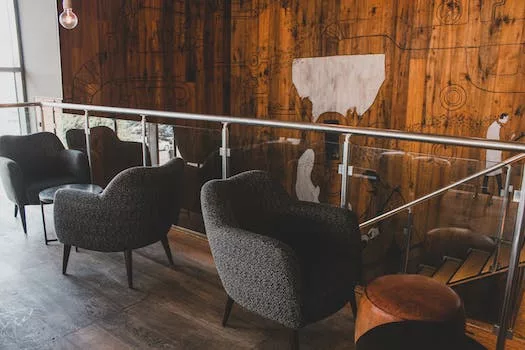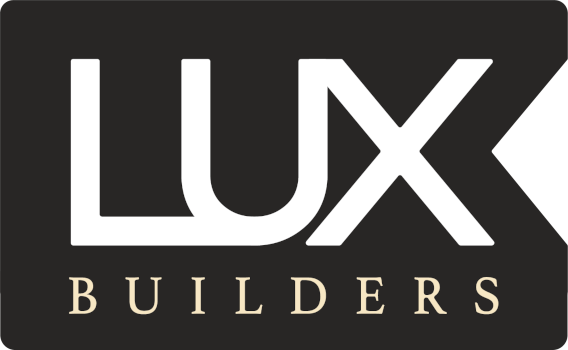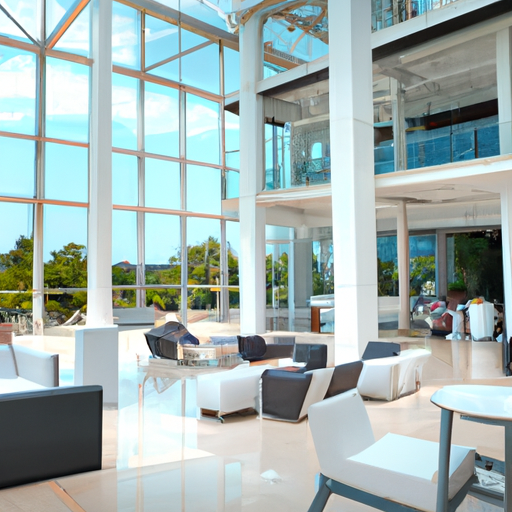Maximizing Space and Functionality in Your Modern Home Office Complex
In today’s fast-paced world, the concept of a home office has become increasingly popular as more and more people are opting to work from home. A well-designed modern complex that caters to the needs of a home office can significantly improve productivity and overall well-being. This article will provide valuable insights on how to design a modern complex that is perfect for a home office, focusing on maximizing space and functionality.
To begin with, it is essential to carefully plan the layout of the complex to ensure that it meets the specific requirements of a home office. This involves considering factors such as the number of rooms, their sizes, and the overall flow of the space. It is crucial to allocate a dedicated room or area for the home office, separate from the living and sleeping areas. This will help create a clear distinction between work and personal life, allowing for better focus and concentration during work hours.
In addition to the layout, it is vital to pay attention to the design elements that contribute to the functionality of the space. One such element is the choice of furniture. Opt for ergonomic furniture that provides adequate support and comfort, such as adjustable chairs and desks. This will not only enhance productivity but also prevent health issues arising from poor posture and prolonged sitting. Moreover, incorporating storage solutions like shelves, cabinets, and drawers will help keep the workspace organized and clutter-free, further contributing to a conducive work environment.
Lighting is another critical aspect of designing a modern complex suitable for a home office. Natural light is known to boost mood, creativity, and productivity, so it is essential to maximize the inflow of daylight into the workspace. This can be achieved by installing large windows, skylights, or glass doors. Additionally, ensure that the artificial lighting in the space is adequate and adjustable, allowing for customization according to the task at hand. A combination of ambient, task, and accent lighting will create a well-lit and visually appealing workspace.
Furthermore, technology plays a significant role in modern home offices, so it is crucial to incorporate the necessary infrastructure to support various devices and connectivity. This includes installing ample power outlets, data ports, and charging stations throughout the space. Additionally, investing in a reliable and high-speed internet connection is a must for seamless communication and efficient work processes.
Another essential aspect of designing a modern complex for a home office is creating a space that promotes focus and minimizes distractions. This can be achieved by incorporating soundproofing measures such as double-glazed windows, insulated walls, and acoustic panels. Additionally, the choice of colors and materials used in the space can also impact concentration and productivity. Opt for neutral and soothing colors like shades of gray, blue, or green, and avoid overly bright or bold hues that may cause visual fatigue.
Lastly, it is important to personalize the home office space to make it more inviting and inspiring. Incorporate elements that reflect the individual’s personality, interests, and work style. This can include artwork, plants, or decorative items that add character and warmth to the space.
In conclusion, designing a modern complex that is perfect for a home office involves careful planning and consideration of various factors that contribute to the functionality and aesthetics of the space. By focusing on aspects such as layout, furniture, lighting, technology, and personalization, one can create a workspace that not only maximizes space but also enhances productivity and overall well-being.
Integrating Technology and Sustainability for an Efficient Home Office Complex

In today’s fast-paced world, the concept of a home office has become increasingly popular as more and more people are embracing remote work and entrepreneurship. A modern complex that is perfect for a home office should not only be aesthetically pleasing but also integrate technology and sustainability for maximum efficiency. This article will discuss how to design such a complex, focusing on the integration of technology and sustainability to create an efficient and eco-friendly home office space.
To begin with, it is essential to consider the layout and design of the complex. A well-designed home office complex should have a dedicated workspace that is separate from the living area to ensure a clear distinction between work and personal life. This separation helps maintain a healthy work-life balance and promotes productivity. Additionally, the workspace should be designed to accommodate all the necessary equipment and furniture, such as a desk, chair, computer, printer, and storage units. Ergonomics should also be taken into account to ensure comfort and prevent strain or injury during long hours of work.
Integrating technology into the home office complex is crucial for efficiency and convenience. A reliable and high-speed internet connection is a must for seamless communication and collaboration with colleagues and clients. Additionally, investing in smart devices and automation systems can significantly enhance the functionality of the space. For instance, smart lighting systems can be programmed to adjust the brightness and color temperature according to the time of day, promoting alertness and focus during work hours and relaxation during breaks. Similarly, smart thermostats can help maintain a comfortable temperature in the workspace while conserving energy.
Incorporating sustainability into the design of a home office complex is not only beneficial for the environment but also for the occupants’ well-being and productivity. One way to achieve this is by using eco-friendly building materials and construction techniques. For example, using reclaimed wood for flooring or furniture can add a touch of warmth and character to the space while reducing the environmental impact. Additionally, opting for energy-efficient windows and insulation can help minimize heat loss and reduce energy consumption.
Another essential aspect of sustainability is energy efficiency. Integrating renewable energy sources, such as solar panels or wind turbines, can significantly reduce the complex’s carbon footprint and utility bills. Moreover, energy-efficient appliances and lighting systems can further contribute to energy conservation. For instance, using LED lights instead of traditional incandescent bulbs can save up to 80% of energy consumption.
Water conservation is another critical aspect of sustainability that should be considered when designing a home office complex. Installing low-flow fixtures, such as faucets and toilets, can help reduce water usage without compromising functionality. Additionally, incorporating a rainwater harvesting system can provide an alternative source of water for irrigation or other non-potable uses.
Lastly, incorporating greenery and natural elements into the design of the home office complex can significantly improve indoor air quality and create a more pleasant and relaxing atmosphere. Adding indoor plants can help purify the air by absorbing pollutants and releasing oxygen, while also providing a visual connection to nature that can boost mood and productivity. Moreover, creating an outdoor workspace or garden can offer a refreshing change of scenery and an opportunity to recharge during breaks.
In conclusion, designing a modern complex that is perfect for a home office requires careful consideration of various factors, including layout, technology integration, and sustainability. By incorporating these elements, one can create an efficient, eco-friendly, and comfortable workspace that promotes productivity and well-being.
Balancing Aesthetics and Ergonomics in a Modern Home Office Complex
In today’s fast-paced world, the concept of a home office has become increasingly popular as more and more people are opting to work remotely. A modern home office complex should not only be aesthetically pleasing but also ergonomically designed to ensure maximum productivity and comfort. Balancing aesthetics and ergonomics in a modern home office complex can be challenging, but with careful planning and consideration, it is possible to create a space that is both visually appealing and functional.
The first step in designing a modern home office complex is to determine the overall layout and design theme. This will help guide the selection of furniture, lighting, and other elements that will contribute to the overall aesthetic of the space. When choosing a design theme, it is essential to consider the type of work that will be done in the space and the preferences of the individuals who will be using it. For example, a minimalist design may be suitable for someone who values simplicity and organization, while a more eclectic design may be more appropriate for someone who enjoys a more creative and visually stimulating environment.
Once the overall design theme has been established, it is essential to consider the ergonomics of the space. Ergonomics is the study of designing products and environments to fit the people who use them. In the context of a home office complex, this means considering factors such as the placement of furniture, the height of desks and chairs, and the positioning of computer monitors and other equipment. Proper ergonomics can help prevent discomfort and injury, making it an essential aspect of any modern home office complex.
One of the most critical ergonomic considerations in a home office complex is the selection of furniture. Desks and chairs should be adjustable to accommodate a variety of body types and postures. Additionally, they should be made from high-quality materials that provide adequate support and comfort. When selecting a desk, it is essential to consider the type of work that will be done at the desk and the equipment that will be used. For example, a graphic designer may require a larger desk to accommodate a drawing tablet and multiple monitors, while a writer may need a smaller desk with ample space for a laptop and a notepad.
Lighting is another essential aspect of a modern home office complex. Proper lighting can help reduce eye strain and fatigue, making it easier to focus on work tasks. Natural light is ideal, so it is essential to consider the placement of windows and skylights when designing the space. Additionally, task lighting, such as desk lamps, can be used to provide focused light on specific work areas. It is also essential to consider the color temperature of the lighting, as cooler temperatures can help promote alertness and productivity.
Finally, it is essential to consider the organization and storage of the space. A clutter-free environment can help promote focus and productivity, so it is crucial to incorporate adequate storage solutions into the design of the home office complex. This may include built-in shelving, filing cabinets, and desk organizers. Additionally, it is essential to consider the placement of power outlets and cable management solutions to ensure a clean and organized workspace.
In conclusion, designing a modern home office complex that balances aesthetics and ergonomics requires careful planning and consideration. By focusing on the overall design theme, furniture selection, lighting, and organization, it is possible to create a visually appealing and functional space that promotes productivity and comfort. With the increasing popularity of remote work, a well-designed home office complex is an essential component of modern living.
Q&A
Question 1: What are the key elements to consider when designing a modern complex for a home office?
Answer 1: The key elements to consider when designing a modern complex for a home office are functionality, ergonomics, natural light, noise reduction, and technology integration.
Question 2: How can one create a comfortable and productive workspace within a modern complex for a home office?
Answer 2: To create a comfortable and productive workspace, focus on providing ergonomic furniture, ample storage, a clutter-free environment, and dedicated zones for different tasks such as computer work, meetings, and relaxation.
Question 3: What are some design tips to ensure a modern complex is aesthetically pleasing while still being functional for a home office?
Answer 3: To ensure a modern complex is aesthetically pleasing and functional, incorporate clean lines, neutral colors, and minimalistic design elements. Additionally, use high-quality materials, incorporate greenery, and ensure proper lighting to create a visually appealing and comfortable workspace.
Conclusion
In conclusion, designing a modern complex that is perfect for a home office requires careful planning and consideration of various factors such as functionality, ergonomics, technology integration, and aesthetics. By incorporating elements such as natural light, efficient space utilization, comfortable furniture, and a well-organized layout, one can create a productive and inspiring environment that caters to the needs of modern professionals working from home.


